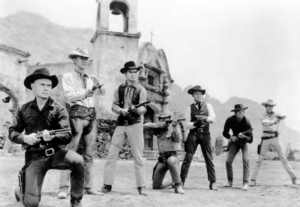by James Scott Bell
@jamesscottbell
There are two kinds of heroes.
One is the man or woman who responds to an immediate crisis, and in rising to the occasion discovers who they really are. This used to be called “the testing of one’s mettle.” It’s the classic Hero’s Journey wherein a character arcs to a transformation.
The second kind of hero responds to a crisis because of a moral vision. The arc is not so much one of transformation but of vindication.
The first hero represents the triumph of an individual, which inspires the community.
The second represents the triumph of a vision, which inspires and strengthens the community. (Where there is no vision, the people perish. – Proverbs 29:18).
Many stories—both fictional and real life—involve the immediate response to a crisis. Think of Sully Sullenberger, who saved an entire plane of passengers by landing his suddenly incapacitated ship on the Hudson River.
Then there are examples of the heroic vision. I would define this as a view of life which combines duty, honor, and courage. Every civilization that manages to survive has told stories of heroic vision. Some of the best movies ever made have it.
One of my favorites is Sergeant York (1941) starring Gary Cooper in an Oscar-winning role. It’s the true story of Alvin C. York, a poor boy from the Tennessee hills who had to hunt to help his family eat, and in the process became a dead shot with a rifle. Drafted during World War I, he sought an exemption based on his Christian beliefs, but was later became persuaded that he had a duty to save lives in a just war. During a battle in France he used his rifle skills to take out a German machine gun nest that was mowing down American soldiers. Single handed he killed 25 of the enemy, and captured 132 more. For this he was awarded the Congressional Medal of —wait for it—Honor.
Another favorite is The Magnificent Seven (1960), the classic Western starring Yul Brynner, Steve McQueen and Eli Wallach. A re-vision of Akira Kurosawa’s The Seven Samurai, it’s the story of a group of gunfighters hired by a poor, Mexican village to save them from the plundering of a bandit gang.
At first, the seven take the job because the age of the gunfighter is over, and there’s nothing but menial jobs for them in town. But as they get to know the villagers, the heroic vision begins to take hold. It’s seven against forty, but they stay and fight because it’s the right fight. It is reminiscent of last stands like the Spartans at Thermopylae, and the Jews of the Warsaw ghetto.
The movie has terrific dialogue, too. Like in the scene where Calvera (Wallach), the leader of the bandits, first encounters the gunfighters. He rides in with his men and finds Chris (Brynner), Vin (McQueen) and Britt (James Coburn) waiting for him. Calvera, not looking overly concerned, remarks on the new walls. “They won’t keep me out,” he says.
“They were built to keep you in,” says Chris.
Calvera mulls it over, and offers to make the seven equal partners. When asked about the poor villagers, Calvera answers with a vision (decidedly unheroic) of his own. He says to Chris, “I leave it to you. Can men of our profession worry about things like that? It may even be sacrilegious. If God didn’t want them sheared he would not have made them sheep.”
Oh heck, it’s better if you watch it:
So in your work, consider giving your Lead characters a heroic vision. Ask yourself some questions:
- What do they believe about duty, honor, and courage?
- Who or what would they die for?
- What will their stand cost them? (A good source of inner conflict)
And flesh out your villain with a vision of his own. Why does he think he’s justified? Calvera has to feed his men, and these villagers were born to be sheep. The clash of visions makes the denouement all the more satisfying. (If you’d like to see how the seven answer Calvera, you can watch the rest of the scene here.)
Comments welcome.

